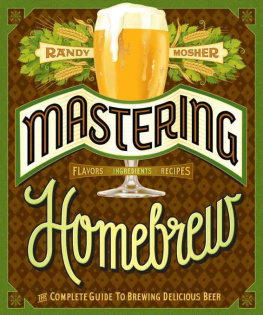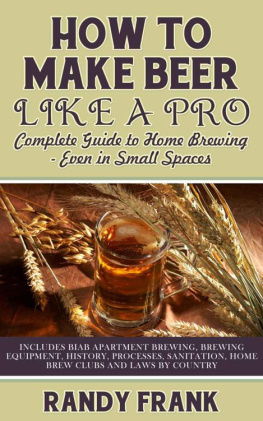
To FRED ECKHARDT,
the grand gentleman of American homebrewing, who did so much to set us all on a civilized and irreverent path.

Fred Eckhardt at the 1998 AHA National Homebrewers Conference in Portland, OR, in 1998. Photo by Edward Bronson.
Copyright 2015 by Randy Mosher.
All rights reserved. No part of this book may be reproduced in any form without written permission from the publisher.
Library of Congress Cataloging-in-Publication Data:
Mosher, Randy.
Mastering Homebrew : the Complete guide to brewing delicious beer /
Randy Mosher.
pages cm
Includes bibliographical references and index.
ISBN 978-1-4521-0551-2 (pb)
ISBN 978-1-4521-2441-4 (epub, mobi)
1. BrewingAmateurs manuals. I. Title.
TP577.M676 2015
641.873dc23
Designed and typeset by Nick Steinhardt, Smog Design, Inc.
Illustrations by Randy Mosher and Nick Steinhardt
Unless otherwise noted, all photographs by Randy Mosher.
Briess is a registered trademark of Briess Industries, Inc. Bairds Malt is a registered trademark of Bairds Malt Limited. Carafa is a registered trademark of Mich. Weyermann GmbH & Co. Caramunich is a registered trademark of Mich. Weyermann GmbH & Co. Cara-Pils is a registered trademark of Breiss Industries, Inc. Palisade is a registered trademark of Select Botanicals Group, LLC. Simcoe is a registered trademark of Select Botanicals Group, LLC. Ribena is a registered trademark of Glaxo Group Limited. Sinamar is a registered trademark of Mich. Weyermann GmbH & Co.
Chronicle Books LLC
680 Second Street
San Francisco, California 94107
www.chroniclebooks.com

Row by row from top left: Homebrew labels by Jim LaFleur, Matteo Pellis/Alberto Bodritti, Jason McLaughlin, Piotr ThoriN Jurkiewicz, Dave Gallagher, Kim Leshinski, ukasz Szynkiewicz, Kim Theesen, ukasz Szynkiewicz, Eric Monson, and Robert Alvord.
Acknowledgments
Thanks to Lyn Kruger and Keith Lemcke of the Siebel Institute for giving me a platform, along with their support and encouragement. Thanks also to Ray Daniels, Chris White, Chris Graham, Stan Heironymous, Penny Pickart, and Ron Pattinson. A special thanks to my friends in Brazil, Argentina, Australia, Italy, and Denmark who sponsored several trips that really opened my eyes to the possibilities of global beer. And, of course, deep gratitude to my partners in 5 Rabbit Cerveceria for letting me share and help shape their journey. Thanks to all my friends in the brewing world who shared their secrets with amazing quotes. Thanks to my ferocious copyeditor, Molly Jackel, for making me look like a real writer. An extra-special thank-you to Tom Schmidlin, whose eagle eye and learned brain saved me from many a misstep.
CONTENTS



Foreword
People often ask, What made the American Craft Beer Revolution happen? Theres an old saying, often attributed to President Kennedy, Success has many fathers, and failure is an orphan. In craft brewing, I think theres no doubt that homebrewers are the many fathers of the explosion of craft brewing. Just about all the pioneering craft brewers started as homebrewers, myself included. Thirty years ago the American commercial beer landscape was a bland horizon of watered-down mass domestics and stale imports. The only way to get a flavorful beer was to brew it yourself. Back then, nobody thought American brewers were even capable of brewing great beer.
Certainly one individual who was a key catalyst to the homebrew revolution was President Jimmy Carter, who, bless him, legalized homebrewing in 1978. The homebrewers of the 1970s and 1980s were passionate and indefatigable. They faced an uphill struggle. Few homebrew clubs or stores existed. Ingredients were often hard to find. No Internet meant no chat rooms, websites, beer blogs, or easy resources for recipes. The available books about brewing were few and mostly focused on commercial brewing. As often as not, early homebrewers had to make it up as we went along. The challenges for homebrewers twenty-five years ago remind me of the challenges our Colonial erabrewing forebears endured. Samuel Adams and the other brewers of his day concocted recipes on the spot to make use of available, harvestable ingredients.
As the American beer landscape has expanded from about 50 breweries in the United States in 1984 to more than 2,000 breweries in 2012, people have often asked me to name the biggest competitors to Samuel Adams. From Day One, my standard answer has been the same. My biggest obstacles are ignorance and apathy. People who dont know about beer and dont care about beer.
Mastering Homebrew holds the promise of extinguishing this ignorance and apathy. No one who reads this book will come away unenlightened or unenthusiastic. In the early years of the Boston Beer Company, I ran up against the long-held assumption that beer is a beverage of the masses that has none of the complexity and nobility of wine. Those days, mercifully, are behind us. Restaurateurs tell us that their beer list says as much about their establishments as their wine list. This is probably the best time in history to be a beer lover, and Randy Mosher is just the person to be our Pied Piper of good beer.
Today theres a brave new world in homebrewing, and that world just got a whole lot better with the publication of this book. Randy has become a worthy literary heir to the late Michael Jackson, the Bard of Beer. Randy is a walking encyclopedia of beer and brewing, and his palate and taste are impeccable. One of Randys great gifts as a teacher is to communicate basic information in a way that is fascinating both to neophytes and experienced brewers.
. Close your eyes and take a sip of your beer. To my mind, there is nothing like the first sip of my first beer of the day. Aaaah!
Now, this is how you start the process of homebrewing. Read, then drink, and then brew. I urge you to drink in this book and learn everything you can before you even start sterilizing your brewing equipment. It will make you thirsty, but it will make you a better brewer. This book will teach you the art and the science of brewing, the chemistry and the mystery, the sensations and the sensational.
Oh, how I wish I had had this book in 1984 when I brewed my first batch of Samuel Adams in my kitchen. The wallpaper might have survived. The beer would have been better, and I would have been better able to evaluate and appreciate my brew. This book might just be the only brewing book most homebrewers will ever need.
So, let me bid you bon voyage as you embark on the wonderful journey Randy has laid out for you.
Cheers!
JIM KOCH
chairman and cofounder, the Boston Beer Company

Next page

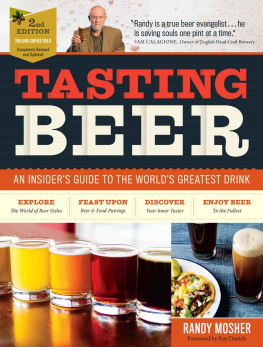
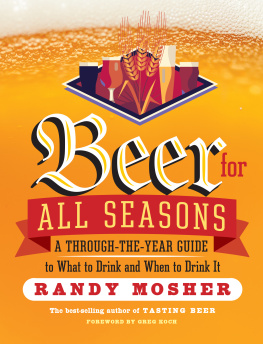
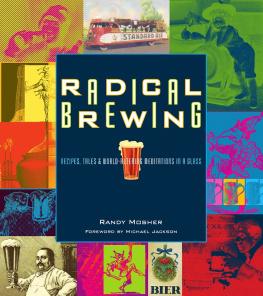
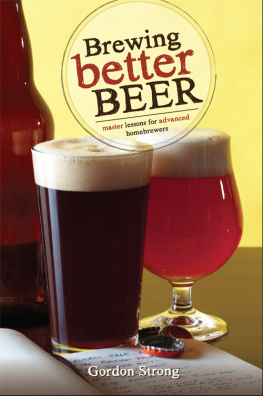
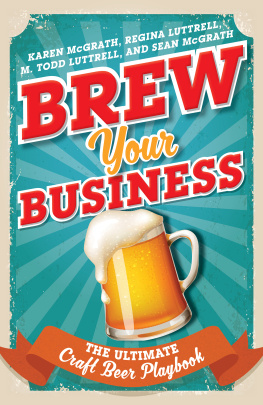
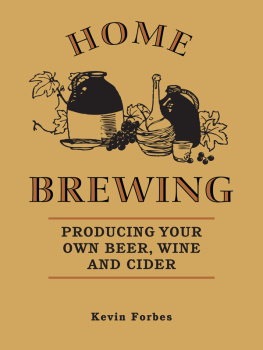

![Randy Mosher - Beer for all seasons : [a through-the-year guide to what to drink and when to drink it]](/uploads/posts/book/74958/thumbs/randy-mosher-beer-for-all-seasons-a.jpg)
